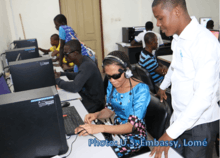Disability in Togo
People with disabilities in Togo face many unique challenges. Disability in Togo is often seen as a curse or sign of witchcraft, leading to poor outcomes for people with disabilities. Accessibility in the country is lacking. However, Togo has signed onto the UN Convention on the Rights of Persons with Disabilities and has created plans to encourage greater inclusion for people with disabilities in the country.

Demographics
Census data from 2010 shows that approximately 1.36% of the population of Togo has a disability of some type.[1] Like many other countries in Africa, children in Togo often become disabled due to various complications, disease, poor diet and other causes.[2]
Cultural attitudes towards disability
Children who are born with a disability in Togo, like in some other West African countries, can face violence at home, school or from other members of the community.[3] Disability is seen as a sign of witchcraft and is considered taboo by some communities.[4] Other times, the disability is considered the "result of a demon in the family."[2] Children with disabilities might also face neglect at home.[5] Children born with a physical disability are viewed as "a non-human spirit," by some families.[6] Some parents deliberately keep their children out of school to protect them from abuse there.[6] People with disabilities in Togo in general were considered cursed and that the disability could be contagious.[7] Violence against children with disabilities and their deaths often goes unreported to authorities.[4] Often entire families are ostracized because of one family members' disability.[2]
People with mental disabilities in Togo may be chained up in places known as prayer camps.[8] These camps are religious institutions where individuals are restrained, not given psychiatric help and are prayed over in an attempt to heal the individuals.[8] In Togo, there are several prayer camps which use different methods, often based on the camp's head pastors' personality.[8]
Policy
There is a lack of inclusion for people with disabilities in leadership positions in Togo.[7] In 2013, Jérémie Yao Vidja, who is visually impaired, became the first person with a disability to run for elected office in Togo and he was later elected to the Togolese National Assembly.[9]
The government in Togo signed on to the UN Convention on the Rights of Persons with Disabilities in 2011.[2] In 2016, Togo's Ministry of Social Action created a committee dedicated to "fostering social inclusion for people with disabilities."[10] In 2017, Universal Health Coverage was given to all students living in Togo.[11]
Infrastructure
Togo's public buildings are still not fully accommodating to people with physical disabilities.[7] In addition, there is no legislation requiring accessibility in public areas.[12]
Education

People with disabilities were first allowed to attend public schools in the 1970s.[7] Also in the 1970s, German and American charities set up special-needs schools, focusing on students with visual impairment.[7] By 2014, there were nine schools and centers for children with intellectual disabilities, with most located in Lomé.[7] Also by 2014, schools for those with hearing impairment had been created.[7]
Efforts at including students with disabilities has started to increase. In 2014, there were hundreds of students with various physical disabilities were enrolled in universities around Togo, including 27 visually impaired students at the University of Lomé.[7]
Non governmental organizations
Non governmental organizations recognize that they need to work closely with the Ministry of Health and the Ministry of Education in Togo.[2] Humanity & Inclusion (HI), started a trial program in Togo and other African countries to help produce 3D-printed prosthetic limbs for amputees in need.[13]
Disability culture
Sports
Participating in sports among people with disabilities is increasing, with hundreds participating in various trials in 2013 leading up to the pan-African competitions.[7] Togo sent a Paralympic athlete, Aliou Bawa, to the 2016 Summer Paralympics.[14]
References
Citations
- Cheryshev, Denis (26 May 2015). "Population With Disabilities - Portail de données du Togo". Knoema. Retrieved 2018-07-29.
- "Relieving disabled children from crippling customs". ReliefWeb. 19 June 2012. Archived from the original on 29 July 2018. Retrieved 2018-07-29.
- "Children with Disabilities in West Africa Experience Violence from the Day they are Born". NYU. 1 February 2018. Retrieved 2018-07-29.
- Obera, Fred (2017-05-16). "Togo where disabled children's accused of witchcraft are imprisoned and ostracised". This Is Africa. Retrieved 2018-07-29.
- Njelesani et al. 2018, p. 4.
- Njelesani et al. 2018, p. 5.
- Abi, Samir (26 July 2014). "Togo sees progress in the struggle for the rights of people with disabilities". D+C. Archived from the original on 3 May 2015. Retrieved 2018-07-29.
- Carey, Benedict (11 October 2015). "The Chains of Mental Illness in West Africa". New York Times. Retrieved 2018-07-29.
- "Revue de presse: Jérémie Yao Vidja, premier malvoyant député au Togo". Visions Solidaires (in French). 2013-08-07. Retrieved 2018-07-29.
- ICRC 2017, p. 3.
- ICRC 2017, p. 1.
- "Disability Access In Togo". Country Reports. Retrieved 29 July 2018.
- Osborne, Charlie (9 July 2018). "3D printing trial launched to help amputees in Madagascar, Togo". ZDNet. Archived from the original on 29 July 2018. Retrieved 2018-07-29.
- "En préparation pour Rio, Aliou Bawa vient de battre son record de Brazzaville en soulevant un poids de plus de 125 kg". Togo News (in French). Archived from the original on 27 February 2018. Retrieved 2018-07-29.
Sources
- ICRC (2017). Disability Rehabilitation Inclusion - Togo (PDF). MoveAbility. Archived from the original (PDF) on 29 July 2018.CS1 maint: ref=harv (link)
- Njelesani, Janet; Hashemi, Goli; Cameron, Cathy; Cameron, Deb; Richard, Danielle; Parnes, Penny (17 January 2018). "From the Day they Are Born: A Qualitative Study Exploring Violence Against Children With Disabilities in West Africa" (PDF). BMC Public Health. 18: 1–7. doi:10.1186/s12889-018-5057-x.CS1 maint: ref=harv (link)